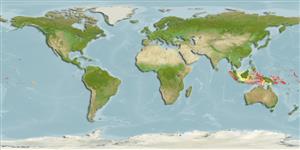>
Gobiiformes (Gobies) >
Gobiidae (Gobies) > Gobiinae
Etymology: Eviota: No etymology given, suggested by Christopher Scharpt: from Latin 'eu' for 'true' and 'iota' for anything very small, in combination 'truly very small' referring to it as being the smallest vertebrate at the time it has benn described by Jenkins (thus, making the suggestion by Scharpt plausible.
More on authors: Jewett & Lachner.
Environment: milieu / climate zone / depth range / distribution range
Écologie
marin récifal; profondeur ? - 35 m (Ref. 86942). Tropical; 7°N - 11°S
Indo-Pacific: Christmas Island in the eastern Indian Ocean to New Caledonia, Solomon Islands, Fiji, Tonga and French Polynesia (Austral Islands); north to Japan (Okinawa and Ryukyu Islands); south to Indonesia (Sulawesi, Lesser Sundas, Banda, West Papua); including Micronesia (Palau, FSM [Pohnpei], and Kiribati).
Taille / Poids / Âge
Maturity: Lm ? range ? - ? cm
Max length : 1.5 cm SL mâle / non sexé; (Ref. 1602); 1.2 cm SL (female)
Description synthétique
Clés d'identification | Morphologie | Morphométrie
Épines dorsales (Total) : 7; Rayons mous dorsaux (Total) : 7 - 9; Épines anales: 1; Rayons mous anaux: 8 - 9. Characterized by semi-transparent body with 6-7 broad brown bars or blotches on side; head with white marks dorsally; longitudinal scale series 23-25; ctenoid scales, absent on head, nape, chest and pectoral fin base; separated pelvic fins, thin membrane joining bases; 7-11 branches of fourth pelvic ray; depth of body 4.5-5.0 in SL (Ref. 90102).
Occurs from less than 5 to between 8 and 24 m. Solitary, rests on bottom. Inhabits exposed coastal reefs and outer slopes (Ref 90102).
Life cycle and mating behavior
Maturité | Reproduction | Frai | Œufs | Fécondité | Larves
Greenfield, D.W. and R. Winterbottom, 2016. A key to the dwarfgoby species (Teleostei: Gobiidae: Eviota) described between 1871 and 2016. J. Ocean Sci. Found. 24:35-90. (Ref. 113727)
Statut dans la liste rouge de l'IUCN (Ref. 130435: Version 2024-1)
Menace pour l'homme
Harmless
Utilisations par l'homme
Outils
Articles particuliers
Télécharger en XML
Sources Internet
Estimates based on models
Preferred temperature (Ref.
123201): 28.2 - 29.4, mean 28.9 °C (based on 744 cells).
Phylogenetic diversity index (Ref.
82804): PD
50 = 0.5000 [Uniqueness, from 0.5 = low to 2.0 = high].
Bayesian length-weight: a=0.00692 (0.00284 - 0.01683), b=3.10 (2.92 - 3.28), in cm total length, based on LWR estimates for this Genus-body shape (Ref.
93245).
Niveau trophique (Ref.
69278): 3.0 ±0.3 se; based on size and trophs of closest relatives
Résilience (Ref.
120179): Haut, temps minimum de doublement de population inférieur à 15 mois (Preliminary K or Fecundity.).
Fishing Vulnerability (Ref.
59153): Low vulnerability (10 of 100).
Nutrients (Ref.
124155): Calcium = 656 [236, 3,125] mg/100g; Iron = 2.5 [0.8, 6.7] mg/100g; Protein = 17.3 [15.0, 19.6] %; Omega3 = 0.107 [0.022, 0.514] g/100g; Selenium = 54.6 [9.2, 253.1] μg/100g; VitaminA = 80.6 [9.0, 653.8] μg/100g; Zinc = 7.56 [3.24, 14.78] mg/100g (wet weight);
